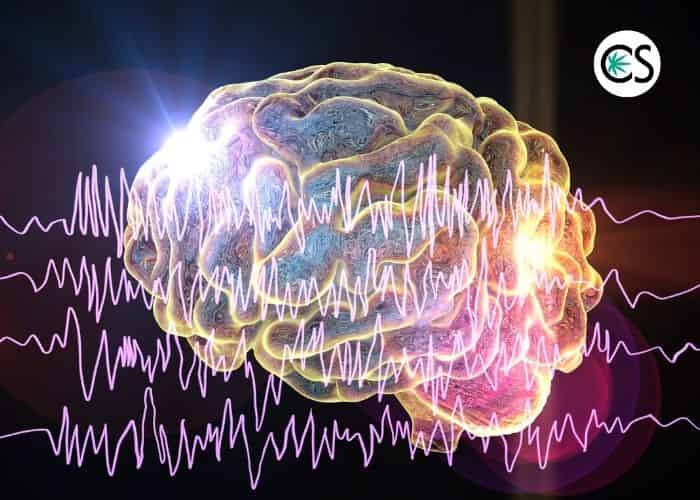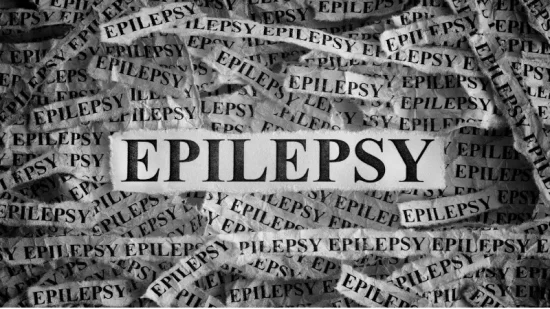According to the CDC, around 3.4 million Americans suffer from epilepsy, representing a staggering 1.2% of the US population. Epilepsy can dramatically impact the quality of life of those afflicted with this condition and can even be fatal.
Our understanding of epilepsy (as with many other neurological conditions) is improving as more and more is learned about the brain and nervous system, which has led to the discovery of numerous potential new treatments.
One such treatment is cannabis (specifically, cannabidiol or CBD for short), which has shown promise in the ability to treat epilepsy symptoms for some years now. This article gives an in-depth look at the role that the cannabis plant may be able to play in treating and managing epilepsy.
A Brief Introduction to Epilepsy
If you’re reading this article, there’s a good chance you already know a thing or two about epilepsy. For those who need a refresher, epilepsy is characterized by unpredictable, chronic seizures.
Epilepsy patients may be diagnosed with epilepsy when they experience two seizures without a known cause. A diagnosis may come at any age (though it is most commonly diagnosed in children and the elderly), and the severity and frequency can vary dramatically from person to person.

Although many people who have epilepsy can still lead a normal life, those experiencing frequent seizures may be unable to drive or work certain jobs. For some epilepsy patients, there is no real warning that one is about to occur and can make these epileptic patients reluctant to perform certain activities.
There are several options available when it comes to the ability to treat epilepsy symptoms, which are not necessarily effective in controlling seizures one hundred percent of the time.
What Causes Epilepsy?
There is no single cause of epilepsy – these seizures may be caused by different factors in different patients.
For children, it may be caused by a congenital disorder or an infection affecting the brain, such as meningitis. Sometimes, babies are born with underlying neurological defects or abnormal wiring of the brain, leading to epilepsy and seizures1 (Bozzi et al., 2012).
Epilepsy can also occur later in life. For older adults, it is commonly brought on by stroke2 (Conrad et al., 2013).
Certain genetic variants or mutations may play a role in the development of epilepsy. Almost 1,000 different genes have been associated with epilepsy, including several genes involved in brain development3 (Wang et al., 2017).
There is also a growing body of evidence to suggest that athletes may have an increased risk of developing epilepsy if they are subjected to multiple head injuries or concussions during their playing time4 (Hellwinkel et al., 2020).
The fact that epilepsy has so many different causes is one reason why it’s often difficult to find an effective treatment for the disease.
What Happens During a Seizure?
An epileptic seizure is not only dangerous and scary to experience, but it can also be quite frightening to witness.
The symptoms vary from patient to patient but could include, uncontrollable jerking movements of the arms and legs5 (Arends, 2018).
Other symptoms include short-term confusion, loss of consciousness or awareness, or emotional symptoms such as anxiety or fear6 (Fogarasi et al., 2007).
Children as well as adults may display a stiffening of the body or prolonged staring7 (Lee & Kirby, 1988). Seizures last from a few seconds to minutes but may last longer8 (Jenssen et al., 2006). Those that do not stop within a few minutes are considered a medical emergency.
An episode is caused by abnormal brain activity, usually in the form of unexpected bursts of electrical activity. Chemical signals in the brain (neurotransmitters) allow for communication from one brain cell (neuron) to another and are either excitatory or inhibitory in nature.

A seizure may occur when there is an imbalance within the excitatory and inhibitory brain circuits, disrupting normal neuronal function.9 (Greenfield Jr., 2013). They are frequently categorized as being focal or generalized.
A focal seizure describes where the abnormal brain activity begins in one specific area of the brain and may or may not result in a loss of consciousness10 (Bagshaw & Cavanna, 2011).
A generalized seizure seems to involve all areas of the brain, affecting cells on both the left and right of the brain.
How to Treat Seizures and Is There a Cure for Epilepsy?
Because the cause of epilepsy is unknown in most people, treatment focuses on using medication to reduce or eliminate seizures instead.
For some individuals, surgery may be an option, which may then reduce or eliminate seizures11 (Wiebe et al., 2001).
Having one seizure does not necessarily mean you will have more in the future, which is why treatment may not be considered until a patient experiences multiple seizures12 (Pohlmann-Eden et al., 2006).
Anti-seizure medications aim to decrease the prevalence, severity, or duration. Because seizures result from abnormal neuronal activity13 (Bozzi et al., 2018), anti-seizure medications work by either decreasing neuronal excitation or increasing neuronal inhibition.
They usually alter either the electrical activity of neurons by affecting intramembrane ion channels, or the chemical transmission between neurons by affecting neurotransmitter levels14 (Porter et al., 2015).
For some anti-seizure medications, the mechanism of action isn’t actually known yet.
One anti-seizure medication used in the treatment of epilepsy is Oxcarbazepine (sold in the United States as Trileptal). This drug is available as an oral tablet, taken once a day either in conjunction with other drugs or alone to treat both focal and generalized seizures.
Although the exact mechanism action of Oxcarbazepine remains unknown, this drug appears to work by blocking neuronal sodium channels, which helps to stabilize over-excited neurons and prevents the type of unexpected bursts of electrical activity that leads to a seizure15 (Kalis & Huff, 2001).
Although this treatment has shown some positive results in people, Oxcarbazepine (and others like it) do not come without side effects. Common side effects of anti-seizure drugs include fatigue, dizziness, blurred/double vision, headaches, nausea/vomiting, and even trouble walking or a lack of coordination.
Because these medications typically come with such a long list of side effects, scientists are always searching for alternative treatments, which is where new and potentially exciting options like CBD come into the picture.
An Introduction to CBD
These days, it seems like there’s a CBD product for almost any ailment imaginable – it’s been touted as a treatment for everything from anxiety to arthritis.
CBD has hit the market so hard and fast that it’s been difficult for the research field to keep up, and the efficacy of CBD as a treatment for many of these conditions hasn’t fully been evaluated in proper clinical trials.
That said, so many people swear by their CBD treatments that it has definitely become an area of interest in the medical field.
CBD stands for cannabidiol, a compound and active ingredient found in the cannabis plant. Although it is a cannabinoid like the better-known THC (also from the cannabis plant), it is considered non-psychoactive, meaning that it doesn’t cause any type of “high” when taken by itself.
However, despite not causing a high, CBD does seem to have other, non-psychoactive effects on the body. It is believed that CBD interacts indirectly with cannabinoid receptors – proteins found on the surface of many different cell types.
Endocannabinoid receptors appear to play a role in the regulation of sleep, mood, appetite, memory, inflammation, and more16 (Zou & Kumar, 2018), leading to the possibility of using CBD to alter these functions.
Can CBD Help with Epileptic Seizures?
In recent years, there has been a lot of research conducted in the area of using CBD to treat seizures. While some clinical trials are ongoing, other work is still being performed in animal models and has not yet reached the clinical phase.
One such study conducted by researchers at the University of North Carolina17 (Zhu et al., 2019) investigated the efficacy of CBD in Angelman syndrome – a rare neurodevelopmental condition characterized by intellectual disability, lack of speech, and seizures.
Using a mouse model of Angelman syndrome, researchers showed that a single injection of CBD could substantially reduce the severity of seizures in mice.
The dosage was enough to cause mild sedation in the animals but did not significantly affect their motor coordination or balance.
CBD also normalized animals’ brain electric activity, suggesting its use may be beneficial to correct abnormal patterns of brain activity seen by electroencephalogram (EEG) in Angelman syndrome patients.
The researchers believe that this study will pave the way for a future clinical trial to assess whether CBD can show a similar benefit in human patients with Angelman syndrome.
In another study, this time with human subjects, researchers at the NYU School of Medicine18 (Devinsky et al., 2018) investigated the role of CBD as a treatment for Lennox-Gastaut syndrome, a severe form of epilepsy that usually can’t be treated with other medications.
In their study, two groups of subjects were given different doses of CBD and compared to a control group who did not receive the drug.
Researchers were specifically assessing the prevalence of drop seizures, characterized by an abrupt loss of muscle tone. In subjects given the higher dose of CBD, they saw a 42% reduction in seizures. In patients with the lower CBD dose, they saw a 37% reduction.
Although the control (placebo) group also noted a 17% reduction, these findings still suggest that CBD can play an important role in reducing the frequency of seizures.
Also, the fact that a lower dose of CBD was still effective provides important information for safe dose levels moving forwards – a lower dose of a drug may result in fewer or less severe side effects.
Speaking of side effects, a majority of patients given CBD in the study above did experience side effects. Side effects experienced by more than 10% of patients included fatigue, decreased appetite, fever, vomiting, upper respiratory infection, and diarrhea.
It’s worth noting that a majority of side effects were reported as being mild or moderate.
FDA Approval of CBD Drug
Data from the studies described above, and many others that indicated a potential role for CBD oil in the management of epilepsy symptoms, led to the groundbreaking decision for FDA approval in 2018 when they approved the first-ever cannabidiol prescription medication.
Called Epidiolex, the treatment is only approved for patients with two very rare forms of childhood-onset epilepsy – Dravet syndrome and Lennox-Gastaut syndrome.
Interestingly, the drug was approved despite researchers not entirely understanding how CBD works in terms of treating epilepsy.
Many scientists now believe that the ability of CBD oil to interact with non-cannabinoid receptors in the brain may actually be more important than its interactions with cannabinoid receptors19 (Devinsky et al., 2014).
As Epidiolex was only approved for use in 2018, there is limited data available to show how well it is working. With more than 15,000 people now reportedly taking Epidiolex, more information should be available in the coming years regarding how effective this treatment is compared to (or in combination with) traditional anti-seizure medications.
Current clinical trials for Epidiolex are ongoing for Tuberous Sclerosis Complex (TSC), a genetic condition characterized by seizures, and Sturge Weber Syndrome, a rare congenital disorder involving seizures.
If the results of these clinical trials are promising, it’s possible that Epidiolex will be approved for use in additional conditions.
Although CBD does appear to be an effective anti-seizure treatment option, there’s still a lot to learn about this drug, how it works, and the other effects it has on patients. One important area of ongoing research is drug interactions.
A majority of patients are already taking some form of anti-seizure medication, so it’s critical that doctors and researchers are sure that CBD is safe to take alongside other compounds.
In the Epidiolex clinical trials performed so far, patients who were also taking valproic acid (sold in the US as Depakote) showed elevated liver enzymes, suggesting an interaction between these two drugs.
Similarly, researchers have learned that a component of the drug Clobazam (Onfi) interacts with CBD as it is broken down, which may account for feelings of fatigue in some patients.
Understanding these reactions in greater detail will be crucial in allowing doctors to safely prescribe CBD-based treatments to epileptic patients.
“CBD is generally well tolerated with a good safety profile … To date, there is no evidence of recreational use of CBD or any public health-related problems associated with the use of pure CBD”
World Health Organization
Using CBD Oil for Seizures
The fact that Epidiolex is an actual FDA approved drug and anti-seizure medication has led many patients to wonder whether using CBD oil for seizures is a good idea.
If you are considering trying CBD oil for epilepsy, there are a few things you should know before you start.
First, it’s important to realize that not all CBD products are created equal. Many CBD products sold at dispensaries or similar outlets go relatively unchecked – there is little regulation in place to ensure these products contain the amount of CBD that they say they do, and there may be many other ingredients also added to these products.
There’s also little consistency between batches, so a product may contain a high level of CBD one month, then lower the next, which may alter consistently results.
That being said, CBD oil is generally considered safe. Not only has Epidiolex become an FDA approved drug as a pure CBD treatment, but the World Health Organization also issued a review in 2018 that stated: “CBD is generally well tolerated with a good safety profile … To date, there is no evidence of recreational use of CBD or any public health-related problems associated with the use of pure CBD”.
Of course, all things considered, it’s essential that you speak with your doctor before getting started on any kind of CBD treatment regimen – especially because seizures are potentially fatal.
CBD for Epilepsy Q&A with Dr. Rachna Patel
How does CBD oil work to reduce or stop seizures?
CBD is believed to reduce or eliminate seizures in a couple of different ways.
Some seizures can occur because the GPR55 receptors get stimulated and lose their inhibition. CBD blocks GPR55 receptors.
So, for the patients in whom the GPR55 is relevant to the cause of their seizures, CBD oil is an effective means to reduce and even eliminate seizures.
In addition, inflammatory processes alter the threshold for seizures and at times cause the progression of seizures. Anti-inflammatory treatments may reduce seizures and may reduce the seizure process itself. At least, as is seen in some experimental models. And it’s been established that CBD has anti-inflammatory properties.
How does CBD oil affect seizures?
CBD has helped my patients in a couple of different ways.
Some patients have experienced complete elimination, while others have experienced a significant reduction in the number of seizures.
But, unfortunately, I have also had the occasional patient who has experienced no effect from CBD on their seizures. Despite this fact, many still opt to give CBD a try being that it’s relatively safe.
In addition, parents as well as research, have reported that reduced seizure frequencies have led to cognitive improvements in children battling seizures.
What type of CBD product would be best to take to assist with seizures?
Due to the potentially fatal nature of seizures, it’s best to consult with a physician who can closely monitor the use of CBD products.
Having said that, overall, internal methods of administration of CBD, such as oral and formulations, like edibles and tinctures, are efficacious for patients, whereas, topicals, such as ointments, lotions, creams, gels, etc. are not.
In terms of selecting the appropriate strength, again, work closely with a knowledgeable and experienced physician. You don’t want to select too weak of a strength that it’s not effective, but you don’t want to select too strong of a strength that you end up experiencing side effects.
Selecting the appropriate strength of CBD products is a critical factor on your CBD journey.
How to use CBD oil for seizures?
In patients, it can often take several hundred milligrams of CBD to effectively treat the seizures.
However, again, it’s important to titrate gradually to the optimal dose under the close supervision of a physician, namely because high doses of CBD has shown to cause mild, but reversible liver injury.
Should I be worried about side effects from CBD?
Read: Side Effects of Using CBD Oil Products
Because patients experiencing seizures oftentimes need up to several hundred milligrams of CBD, they do run the risk of experiencing side effects.
The potential side effects of CBD products that all medical users should be aware of include tiredness, diarrhea, and decreased appetite & weight. As also mentioned above taking high doses of CBD has shown to cause mild, but reversible liver injury, so be sure to consult your physician.
Should I be worried about CBD interacting with my anti-seizure medications?
First and foremost, it’s important that you do not abruptly or even gradually stop taking your anti-seizure medications. Any changes to your anti-seizure medication should be made under the supervision of a physician.
With that being said, patients taking CBD along with anti-seizure medications have to especially be careful.
Research on the pharmaceutical version of CBD – known as Epidiolex – showed an elevated liver enzymes level in children who were given CBD with the anti-seizure medication Valproic Acid (Valproate).
The effect was related to the dose of CBD these children were taking. In ⅔ of the patients, the researchers either reduced or eliminated the Epidiolex or they reduced or eliminated the Valproate and the liver enzymes level went back down to normal.
In one of the patients, the researchers did not reduce or eliminate the Epidiolex and the liver enzyme levels went back down to normal anyway.
Another study looked at the effects of CBD on an anti-seizure medication called Clobazam. They looked to see what happened when 13 kids with Epilepsy were given Clobazam with CBD.
They found that CBD led to less break-down of Clobazam. Basically, it stuck around longer than normal. And, as a result, the doses of Clobazam that these kids were on had to be reduced. And, in turn, the kids experienced fewer side effects of the Clobazam.
Overall, patients on anti-seizure medications need to have their liver function monitored closely. And, patients need to be monitored closely in general as dose adjustments may be required either of the CBD or the anti-seizure medication.
References
1Bozzi Y, Casarosa S, Caleo M. Epilepsy as a neurodevelopmental disorder. Frontiers in psychiatry. 2012 Mar 19;3:19. doi: 10.3389/fpsyt.2012.00019.
2Conrad J, Pawlowski M, Dogan M, et al. Seizures after cerebrovascular events: Risk factors and clinical features. Seizure. 2013;22(4):275-82. doi:10.1016/j.seizure.2013.01.014.
3Wang J, Lin ZJ, Liu L, Xu HQ, Shi YW, Yi YH, He N, Liao WP. Epilepsy-associated genes. Seizure. 2017 Jan 1;44:11-20. doi: 10.1016/j.seizure.2016.11.030.
4Hellwinkel JE, Anderson FL, Trofa DP, Deitrich MP, Dansby JD, Noble JM, Bottiglieri TS. Post-Traumatic Epilepsy after Sports-Related Concussion: A Case Report. Neurotrauma Reports. 2020 Jul 1;1(1):42-5.
5Arends JB. Movement‐based seizure detection. Epilepsia. 2018 Jun;59:30-5. doi: 10.1111/epi.14053
6Fogarasi A, Tuxhorn I, Janszky J, Janszky I, Rásonyi G, Kelemen A, Halász P. Age‐dependent seizure semiology in temporal lobe epilepsy. Epilepsia. 2007 Sep;48(9):1697-702. doi: 10.1111/j.1528-1167.2007.01129.x
7Lee SI, Kirby D. Absence seizure with generalized rhythmic delta activity. Epilepsia. 1988 Jun;29(3):262-7. doi: 10.1111/j.1528-1157.1988.tb03716.x
8Jenssen S, Gracely EJ, Sperling MR. How long do most seizures last? A systematic comparison of seizures recorded in the epilepsy monitoring unit. Epilepsia. 2006 Sep;47(9):1499-503. doi: 10.1111/j.1528-1167.2006.00622.x
9Greenfield Jr LJ. Molecular mechanisms of antiseizure drug activity at GABAA receptors. Seizure. 2013 Oct 1;22(8):589-600. doi: 10.1016/j.seizure.2013.04.015
10Bagshaw AP, Cavanna AE. Brain mechanisms of altered consciousness in focal seizures. Behavioural neurology. 2011 Jan 1;24(1):35-41. doi: 10.3233/BEN-2011-0312
11Wiebe S, Blume WT, Girvin JP, Eliasziw M. A randomized, controlled trial of surgery for temporal-lobe epilepsy. New England Journal of Medicine. 2001 Aug 2;345(5):311-8. doi: 10.1056/NEJM200108023450501
12Pohlmann-Eden B, Beghi E, Camfield C, Camfield P. The first seizure and its management in adults and children. Bmj. 2006 Feb 9;332(7537):339-42. doi: 10.1136/bmj.332.7537.339
13Bozzi Y, Provenzano G, Casarosa S. Neurobiological bases of autism–epilepsy comorbidity: a focus on excitation/inhibition imbalance. European Journal of Neuroscience. 2018 Mar;47(6):534-48. doi: 10.1111/ejn.13595
14Porter RJ, Kupferberg HJ, Hessie BJ. Mechanisms of action of anti-seizure drugs and the anticonvulsant screening program of the National Institute of Neurological Disorders and Stroke. Int J Clin Pharmacol Ther. 2015 Jan 1;53:9-12. doi: 10.5414/CP202212.
15Kalis MM, Huff NA. Oxcarbazepine, an antiepileptic agent. Clinical therapeutics. 2001 May 1;23(5):680-700. doi: 10.1016/s0149-2918(01)80019-9.
16Zou S, Kumar U. Cannabinoid receptors and the endocannabinoid system: signaling and function in the central nervous system. International journal of molecular sciences. 2018 Mar;19(3):833. doi: 10.3390/ijms19030833
17Gu B, Zhu M, Glass MR, Rougié M, Nikolova VD, Moy SS, Carney PR, Philpot BD. Cannabidiol attenuates seizures and EEG abnormalities in Angelman syndrome model mice. The Journal of clinical investigation. 2019 Nov 4;129(12). doi: 10.1172/JCI130419
18Devinsky O, Patel AD, Cross JH, Villanueva V, Wirrell EC, Privitera M, Greenwood SM, Roberts C, Checketts D, VanLandingham KE, Zuberi SM. Effect of cannabidiol on drop seizures in the Lennox–Gastaut syndrome. New England Journal of Medicine. 2018 May 17;378(20):1888-97. doi: 10.1056/NEJMoa1714631
19Devinsky O, Cilio MR, Cross H, Fernandez‐Ruiz J, French J, Hill C, Katz R, Di Marzo V, Jutras‐Aswad D, Notcutt WG, Martinez‐Orgado J. Cannabidiol: pharmacology and potential therapeutic role in epilepsy and other neuropsychiatric disorders. Epilepsia. 2014 Jun;55(6):791-802. doi: 10.1111/epi.12631







